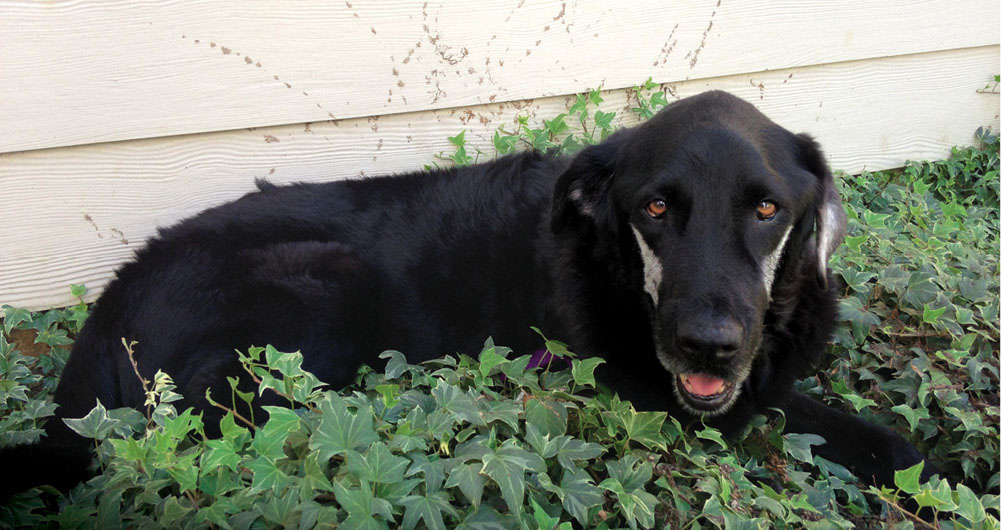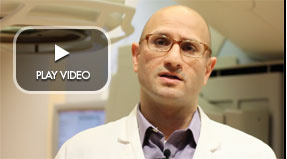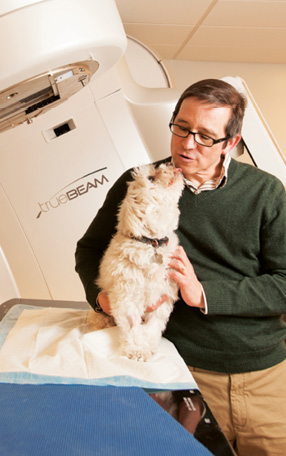
Companions in cancer
Melanoma treatment in dogs provides hope for humans
When Krista DeZerega-Thomson and her family learned that Rohan, their beloved Labrador retriever, had melanoma — an aggressive cancer that affects both people and dogs — their hearts fell. Because it had already spread to Rohan’s lungs and lymph nodes, their veterinarian told them that with no conventional treatment options available, he likely had only two more months to live.
Then the vet mentioned that Michael Kent, an associate professor of radiation oncology in surgical and radiological sciences at the UC Davis School of Veterinary Medicine, was conducting a unique clinical trial to treat cancers like Rohan’s. Kent, director of the UC Davis Center for Companion Animal Health, remembers Rohan as a perfect candidate for the trial, part of a remarkable collaboration with Arta Monjazeb, assistant professor of radiation oncology at the UC Davis Comprehensive Cancer Center.
“We are addressing the most challenging presentation in cancer medicine: a tumor that has already metastasized,” says Kent. “The Cancer Center-Vet Med partnership is a great strategy to simultaneously advance treatments for animals and humans.”
Blending radiation with immunotherapy
The novel treatment approach blends radiation and immune therapies to break up the cancer, then stimulate a dog’s or a person’s own defenses to recognize the tumor fragments as foreign and mount an attack to destroy them. According to Monjazeb, it effectively helps create an individ-ualized vaccine against the cancer.
Monjazeb has been fascinated with immunology since he par-ticipated in research as an undergraduate at UC Berkeley. During medical school he also obtained a Ph.D. in cancer biology, focusing on the role of inflammation and immunology in cancer. After medical school he specialized in radiation oncology. His interest in the role of the immune system in human disease continued, and he performed a research fellowship in cancer immunotherapy.
“Marrying radiotherapy with immunology is bringing about a revolution in cancer therapy,” says Monjazeb. “Based on advances we are seeing now, we should be able to effectively treat patients who were previously considered incurable.”
At the Center for Companion Animal Health in Davis, Rohan underwent four radiation treatments aimed at his tumor and lymph nodes. Radiation therapy on its own has many immunological effects, Monjazeb explains. For one, it kills tumor cells, making them more recognizable by the person’s immune system. Dying cancer cells release a surge of proteins that activate the host’s immune defenses, which generate cancer-specific white blood cells to fight the cancer. Secondly, radiation breaks up the tumor, allowing the body’s circulating immune cells in the blood to gain better access to the remaining tumor. In addition, radiation destroys immune-suppressive cells recruited by the cancer that have kept the host’s immune system at bay.
In addition to giving him radiation treatments, veterinarians injected immune-enhancing drugs into Rohan’s tumor site to stimulate his immune system to mount a local response to the tumor.
At home in between treatments, Rohan received oral drugs that helped stop the immune suppression caused by his tumor. The drugs put a damper on regulatory T-cells that normally lower the body’s immune response — a safeguard that keeps our immune system from recognizing our body as foreign, but also hampers fighting a tumor.
“The combination of radio-therapy and immunotherapies is like putting one foot on the gas and taking the other off the brake at the same time,” says Monjazeb. “This strategy promotes a maximal response against the cancer.”
Both Kent and Monjazeb were very pleased with how Rohan and the other dogs in the trial responded to the unique therapy. Rohan lived another six months, three times longer than had been predicted without therapy. And, as importantly, his quality of life remained good throughout the treatment.
“Every time he came out of treatment, he had more energy,” recalls DeZerega-Thomson, whose family includes her husband and two children, ages 8 and 10. “We took him to the lake and hiking — he really enjoyed his last months.”
Dogs as models
Monjazeb notes that dogs make excellent experimental models for human cancers, and that the collaboration with the vet school has allowed him to rapidly advance his research. Spontaneous cancers in dogs behave much more like those in humans than do cancers induced in lab mice, he explains. This makes results from dog trials much more likely to predict outcomes in people with cancer. The fact that dogs with such advanced disease responded so well to even a short course of therapy is extremely encouraging, and he hopes to soon begin safety trials in human patients who have metastatic melanoma.
“Partnerships of this kind can be done only at UC Davis, where there is strong medical and veterinary clinical research on people and animals being done in such close proximity,” Monjazeb says. “I know of no other place in the country that provides this opportunity.”
Kent agrees, and looks forward to collaborating more often with the Comprehensive Cancer Center. He emphasizes that clinical trials for pets carry similar ethical concerns and require safeguards similar to those for humans.
“Research in companion animals must not diminish quality of life,” he says. “Treatments must be safe, and they must not cause harm.”
When Rohan did poorly several months after finishing his treatment, and it was clear that the cancer had spread throughout his lungs, everyone agreed that it was time to let him go.
DeZerega-Thomson relates how as soon as they realized that Rohan would not survive much longer, Kent met the family outdoors, where Rohan was happiest, and very peacefully put him to sleep.
“We would definitely do it all again,” says DeZerega-Thomson. “It was a privilege to participate in research that not only helped Rohan, but might one day also help others — pets, as well as people.”


